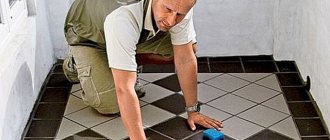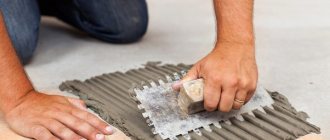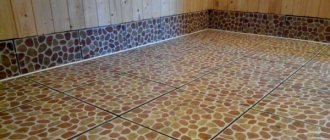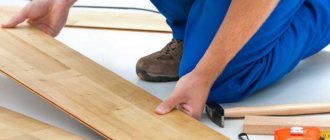Stone-paved paths in the local area or in the garden are beautiful and very practical. Paving stones made from natural materials are not available to everyone, but artificial stone, which appeared relatively recently, does not have this drawback. More and more homeowners are choosing this durable and hard-wearing decor for their spaces. Another advantage is its simple installation, which you can do yourself. We will analyze all the stages of laying paving slabs so that you can easily lay out the path with your own hands.
What to consider when designing
We want to start step-by-step instructions for laying paving slabs with your own hands by creating a project. This is a really important stage. A correctly drawn up project will help you correctly calculate the required amount of materials, find the correct trajectory for the location of a path or platform, and choose an installation technology so that it will last for many years.
If you are designing a path, it is important to lay out a trajectory: this is done along the most “passable” sections. The location for the site is selected in accordance with the site plan. It is important that there are as few “dangerous” objects as possible on the path of the path or near the site (ideally, there should be none at all). Underground communications are considered potentially dangerous. If they are to be laid or repaired, all work must be completed before paving begins.
Close proximity of bushes or trees, especially large ones, is undesirable. Their root system will grow over time and begin to destroy the base of the structure. Therefore, young trees or seedlings need to be transplanted further away. Old trees may need to be removed. If you decide to leave them, build a new path or place the site at a distance of at least 3 m.
After selecting the installation site, the type and condition of the soil are assessed. If it is a relatively flat surface with normal load-bearing capacity, no additional work will have to be carried out. Loam, gravel or sandy loam are good bases. Silty or clayey soil will have to be additionally reinforced with a concrete base. Difficulties will also arise during construction on difficult terrain. Here it will be necessary to arrange flat terraces on which fragments of the path will be located.
Next, determine the size and shape of the paths or platforms. An important parameter is width. There are no strict requirements here, but if you are making a path from paving slabs with your own hands, it is important that it is comfortable for two pedestrians to walk on it and for them to pass easily. The average width is 100-120 cm. The width of the platform is determined depending on the purpose. Well, if it is a multiple of the width of the tile, then the amount of trimming will be significantly reduced.
Another important point is the arrangement of water drainage. Without it, rain and melt water will flow into the cracks between the elements, penetrate into the base and destroy it. Therefore, it is necessary to provide for a longitudinal or transverse slope of the structure. It should not be large: for longitudinal, 3-4˚ is enough, for transverse - 1-2˚. Small gaps can be provided to allow liquid to drain away.
Instagram domozmsk
Pixabay
- Landscape
How to make concrete paths at your dacha with your own hands
Recommendations for caring for the coating
They are quite simple:
- The path must be swept regularly and promptly cleared of debris and sand.
- In case of serious contamination, oil stains, wash with water from a hose.
- Remove snow with shovels made of any material other than metal - it spoils the integrity of the coating. You should not sprinkle salt on an icy tile; it destroys the product and forms a coating on it.
- Swelling areas of the path can be easily repaired. Therefore, it is easy to remove individual tiles, level the base and put them in place.
- To protect against moisture, you can purchase a water repellent solution.
It is worth considering that a pavement made by vibration compaction will last 100 years or more. But vibration-cast products wear out much faster and last much less.
Photo: multi-colored paving stones
What materials and tools are needed
Before you start laying paving slabs with your own hands, you need to prepare. Calculate the required amount of materials in accordance with the prepared plan. First, choose the cladding. It can be of different sizes and shapes. The easiest way is to lay quadrangular elements: in a line, herringbone, diagonally. Combinations of “bricks” and “squares” look good.
Particular attention should be paid to the thickness of the tiles. It’s better not to choose the thinnest one at 20 mm. It's too fragile. For pedestrian paths, elements with a height of 40 mm are suitable; for areas where cars will pass or park, choose elements with a thickness of at least 60 mm.
After the cladding is selected, curbs are selected. They should be in harmony with the decor. Concrete stone is a popular choice, but plastic pieces may also be available. Their number is calculated by multiplying the length of the path by two. Then divide the resulting number by the length of the border element.
In addition, you will need crushed stone, sand and cement. They are used to create the basis for installing the cladding. Geotextiles are also needed for laying drainage.
From the tools you need to prepare a rubber mallet, a rammer, usually a cord with pegs, a building level, a rake and a shovel. If trimming is intended, an angle grinder with a diamond disc is additionally prepared for cutting parts.
Construction of the first part of the load-bearing layer - leveling
The next stage in the construction of a garden or country path is the construction of a load-bearing layer - the main part of the foundation.
First of all, we lay a leveling layer of crushed stone 5-7 cm thick, which is essentially part of the load-bearing layer of the foundation. It is on this that we will install the curb stone.
Having evenly distributed the crushed stone over the entire surface of the bed of the infield path, we must compact it. We control the level of crushed stone by measuring the distance from it to the string. It should be equal to the height of the curb stone.
At the end of compaction, sprinkle the leveling layer with sand and water. It is advisable to do this, since sand penetrates inside between the crushed stone and makes the crushed stone layer monolithic.
How to lay paving slabs on sand with your own hands
Let us examine in detail the technology for installing cladding on a sand base using the example of arranging a path.
Site marking
Straight lines are marked using pegs with cords stretched between them. They start from any edge, be sure to check the plan constructed in advance. The length of the fragment is measured with a tape measure, and pegs are installed every three to five meters. The width of the path is planned taking into account the thickness of two curbs plus five to ten centimeters for their installation.
After installing the pegs, check the accuracy of their position. On rectangular fragments of the trail, the lengths of the diagonals are measured. They must match exactly.
Then strings are pulled between the stakes, which will mark the contours of the future structure. They are transferred to the ground. The contour can be drawn with a sharp tool or indicated with a sprinkle: chalk powder, lime, etc.
Instagram tanya_landscape
Instagram suvjul
Preparing the base
The quality of installation and the service life of the cladding depend on the preparation of the base. First of all, you need to completely remove the fertile layer of soil. If this is not done, the organic matter will rot and the base will sag, and this is undesirable. All plants and parts of their rhizomes are also removed. Otherwise, they will sprout from under the laid decor and destroy it.
The depth of the resulting trench is usually about 30-40 cm. It is important to make a slope to remove moisture.
The easiest way to level the base is with a regular rake. After this, the earth is compacted. You can lightly moisten the soil to make it easier to compact. The bottom should be level, but with a slight slope.
Instagram miladyknit
Instagram miladyknit
- Landscape
How to make a path from wood cuts with your own hands
Installation of curbs
The technology for laying paving slabs requires the mandatory installation of curb stones. They serve as support for the edges of the structure and prevent it from “creeping” due to swelling of the soil. Curbs are fixed to concrete mortar. The work is performed in the following sequence.
- Preparing seats for curb stones. To do this, small trenches are dug along the edges of the prepared pit. Their depth should be 7-10 cm, width - 3-5 cm more than the width of the curb.
- Mix a concrete mixture of cement, sand and crushed stone. Proportions - 1:3:2. Add enough water to form a thick solution.
- They start by pouring liquid concrete in small portions into the prepared holes. It is distributed over the base, a stone is placed, aligned with a stretched cord, and the part is hammered down with a rubber mallet.
- All curbs are installed in the same way.
After installing all the elements, you need to give the solution a day or a little more for initial hardening.
Mandatory requirements for paving
The main problem of an individual developer is traditionally a limited budget. The technology for laying figured paving elements (FEM) for decorating paths can be simplified. However, some mandatory requirements remain unchanged:
- arrangement of a rigid spatial “trough”;
- removing the topsoil, replacing it with crushed stone or sand with layer-by-layer compaction;
- ensuring the drainage of rainwater due to the slope of the surface.
Manufacturers produce latex and polymer molds for tiles; if you have free time, you can make tiles yourself.
Forms for pouring FEM tiles.
Renting a vibrating plate provides additional costs; its installation is simple; most home craftsmen can assemble the equipment.
Homemade vibrating plate.
Manual tamping is easier to make; you will need a log and a block as a handle.
The simplest manual rammer.
What are the benefits of concrete paving stones?
It is no coincidence that the products are actively used for paving paths and constructing parking lots. This is due to their excellent performance characteristics:
- high strength and wear resistance, allowing to withstand the constant movement of a large number of people and vehicles (even trucks);
- resistance to the external environment: sunlight, temperature changes, precipitation and wind;
- durability;
- environmental safety.
Concrete paving slabs
The material can be reused many times. Unlike asphalt, paving stones do not react to heat. And for its use in regions with cold climates, special additives are added to the composition to increase frost resistance.
In addition to functionality, the material also has decent aesthetic characteristics, allowing you to create not only a practical, but also an externally attractive coating. What is very convenient is that you can lay paving stones yourself, without resorting to the services of specialists. It is important to decide on the design in advance.
Paving slabs “Roman beech”
Paving options
- When placing products in the direction of movement, the path looks dynamic.
- Laying the slabs crosswise creates the impression of staticity and solidity.
- Decorative paving looks very aesthetically pleasing, in which the tiles are arranged in a circle or in a herringbone pattern.
A diagram of the installation of paving stones is shown in the photo.
Layout of paving stones
The best manufacturers
Let's take a closer look at 5 well-known manufacturers in the CIS countries that have proven themselves with high-quality products and affordable prices.
"Siyan"
Russian paving slab factory. Each view is fully painted over. Therefore, when worn out, the products do not lose the integrity of the color coating. SIYAN produces tiles of various shapes and thicknesses. It is suitable for laying garden paths, driveways, and highways. Prices are available. The products are durable and reliable.
"Unigran"
A Ukrainian manufacturer that has its own raw material base, from which it produces wall blocks, tiles, and borders. All products are certified by the ISO 9001:2015 quality control system.
Paving, ceramic coating is created using vibrocompression technology. The company offers more than 30 types of goods. All tiles are frost-resistant, with a service life of 50 years.
"Stellard"
The company and production are located in Russia. The products are manufactured using the method of semi-dry vibrocompression. German equipment is used to create tiles. The plant carries out individual orders for the production of tiles of various shapes and colors. The work of the workshops is automated.
Stellard products are a worthy replacement for old road or garden surfaces.
"White Hills"
A Russian enterprise that has been specializing in the production of facing bricks, stone, tiles, paving slabs and related decorative elements for more than 10 years. With a wide selection of textures, shapes, colors. The paving stones they produce are very popular, imitating natural stone such as gabbro and diabase.
"Steingot"
A relatively young Russian enterprise. It was founded in 2015. Engaged in the production of paving slabs and facing materials. The workshops are equipped with modern German equipment. The production process is automated. The main consumer market is Moscow and surrounding regions.
Whatever manufacturer you choose, a garden covering decorated with paving slabs will be a profitable, convenient, and most importantly, durable option for arranging a summer cottage. Construction is easy to do yourself. And if you want to post entire drawings, you can invite specialists to help you who will bring your ideas to life.
GARDEN PATHS MADE OF NATURAL STONE
Garden paths made of natural stone add special, natural beauty and decorativeness to the area. Artificial concrete paving stones will never be able to compete in beauty with natural stone. Having chosen natural stone, we always try to use artistic paving techniques. Mosaic patterns in paving paths look incredibly beautiful. Most often in landscape design, natural stone is used to create garden paths on a concrete base. Paths with lawn joints are well suited for edging a garden or walking into a wooded area. Natural stone is used for cladding plinths and retaining walls.
Facing the base and laying stone - the price depends on the complexity of the design. Stone paths cost of work in Moscow , on average from 750 rub.m2
Laying wild stone
Path made of stone
Tile processing
To process the material, hydrophobic agents are used to protect each tile from mold and improve the overall appearance of the products.
- The process consists of individually processing the elements with this solution by dipping and thoroughly drying. The procedure is repeated twice.
- After the material is fully prepared and processed, individual elements that have chips are rejected.
- Defective products do not need to be thrown away. They can be used for finishing in inconspicuous areas.
Installation of curbs
After completing the installation of the drainage system, the installation of curbs begins. They can be made of different materials - stone, wood or made of brick. Plastic piece tiles are especially popular among craftsmen.
They are distinguished by their aesthetic appearance, ease of installation and high degree of wear resistance. When choosing borders, you should take into account their harmonious combination with the main coating.
Criterias of choice
When choosing a suitable material, you first need to focus on its cost. High-quality tiles that will last for several decades are made mainly from natural raw materials and have a relatively high price. The following types of raw materials are most often used in the manufacture of finishing materials:
- hard and soft varieties of natural stone;
- fake diamond;
- polymer sand mixtures;
- concrete mixtures;
- firing materials.
An additional criterion for choosing a finishing material is the thickness of the tile. To design, for example, narrow paths, it is quite possible to choose a material whose thickness does not exceed 0.4 - 0.6 cm. If you are laying a road or parking lot, you need to choose especially durable tiles, the thickness of which varies over 0.8 cm.
Tiles made from a mixture of concrete Source plitkaoskol.ru











